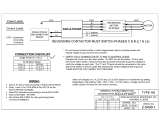
10 CTV-PRB004-EN
Chiller Selection and Electrical Specification
Standard Components of Trane Starters
• A 4 kVA control-power transformer (CPT) supports all of the chiller auxiliary power needs—
3 kVA control-power transformer supplied with AFDs.
• Primary and secondary current transformers (CTs) support the overload and momentary power
loss protection functions of the unit controller.This allows amps per phase and percent amps
to be displayed at the unit controller.
• Potential transformers (PTs) support motor protection functions such as under/overvoltage
within the unit controller.This allows voltage per phase, kilowatts, and power factor to be
displayed at the unit controller.
• Grounding provisions are standard.
• A terminal block for line power connection is standard. Load-side lugs are standard for remote
starters.The lug sizes and configuration are shown on the submittal drawing.TheTrane
®
AFD
has a circuit breaker as standard. Medium-voltage starters have provisions for a bolted
connection.
Chiller Selection Report
The following terms are found on a typicalTOPSS product report. Review the example selection
output report shown in Figure 4, p. 12.
Electrical information
Usually the primary RLA (incoming line), compressor motor RLA, and kW of the chiller are used as
nameplate values. In this section, we will review the typical electrical data presented on the
selection report.
A. Motor size (kW). The motor size is listed on the program report based on its output kW.The
output kW is the motor’s full, rated power capacity.There is an amperage draw associated with the
motor size called full-load amps (FLA). FLA is the amperage the motor would draw if it were loaded
to its full rated capacity, i.e. the motor size.The FLA is not available from the chiller selection
program, but it can be obtained from motor data sheets upon request.
B. Primary power (kW). The primary power is the power the chiller uses at its design cooling
capacity.The primary power will always be less than or equal to the motor size.
C. Motor locked-rotor amps (LRA). There is a specific locked-rotor amperage value associated
with each specific motor.This is the current draw that would occur if the rotor shaft were
instantaneously held stationary within a running motor. LRA is typically six to eight times the motor
full-load amps (FLA). LRA is also used commonly in discussing different starter types and the
inrush amperages associated with the motor start. For example, a wye-delta starter will typically
draw approximately 33 percent of the motor LRA to start. A solid-state starter will draw
approximately 45 percent of the motor LRA to start.
D. Primary rated-load amps (RLA [incoming line]). The RLA is also commonly referred to as
the selection RLA or unit RLA.This is the amperage that is drawn on the line side when the chiller
is at full cooling capacity. Nameplate RLA (usually the same as primary RLA [incoming line]) is the
key number used to size the starter, disconnects, and circuit breaker. Primary RLA (incoming line)
is also the value used to determine the minimum circuit ampacity (MCA) for sizing conductors.
Primary RLA (incoming line) is always less than or equal to the motor full-load amps (FLA).
E. Compressor motor RLA. This is the amperage between the motor and starter or AFD. If the
unit is a starter, the compressor motor RLA will be almost identical to the primary RLA (incoming
line). If the unit is an AFD, typically, the compressor motor RLA will be larger.This value is used
to size the AFD.The primary RLA (incoming line) is lower due to the improved power factor of the
AFD.
CTV-PRB004.book Page 10 Sunday, December 18, 2011 6:39 PM





















